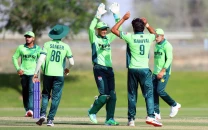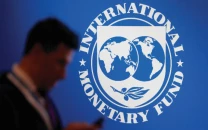The Sachin effect
When I watch Sachin's brilliant 98, I marvel at absolute audaciousness of his strokes, decimating once-great bowling.

The writer is a sub-editor on the Opinions and Editorials pages of The Express Tribune
The fact that Sachin’s mere ouster could lead to his team completely falling apart painted a true picture of Indian cricket during the 1990s. This became the inevitable mantra of Pakistani players and fans during India-Pakistan encounters: get Sachin out, win match. In a team that wasn't short of talented batsmen, it seemed that Sachin was the only one who was not only brave enough to dream big, but also had the ability to actually do something about those dreams, the rest of the side often seeming too overawed by the opposition, the conditions, the situation, you name it. It must have been frustrating to be Sachin during these times, a fearless man stuck among those ready to break down at the slightest hint of pressure. Little did he know that his attitude towards the game and his batsmanship would soon inspire a new generation of batsmen, who would not take aggression from the opposition lying down and who would not all collapse in a heap every time Sachin was dismissed.
This fact was brought home to Pakistanis soon enough. March 1, 2003. A must-win World Cup game for both teams. Pakistan bat first and put on a competitive 273. In years past, such a score would have been enough to annihilate opposition, especially with the kind of bowling attack Pakistan possessed. The same was expected this time around too. But Pakistani fans had failed to see the signs of the times: that their team was one in structural decline; that their opposition was not the India of yore, timid and lacking in confidence, allowing their neighbours to often walk all over them. This was a new India and Sachin wasn’t the only one who dreamt big in this team. It had the likes of Sehwag, Yuvraj and Kaif in its ranks and was led by a man as ambitious as Sachin himself: Sourav Ganguly. This new generation shared Sachin’s bold aspirations and was clearly inspired by the great man. Now when I watch his brilliant 98, I can marvel at the absolute audaciousness of the stroke play and the decimation of a once-great bowling attack. Back on that March day, however, watching his innings was a highly painful experience. With one devastating stroke after the other, India galloped towards the target with no miracles in sight this time, the two Ws bowing out on a depressing note, two greats who deserved to go out on a high but who could only wince as each boundary hastened the end of their careers
That innings changed the equation of India-Pakistan encounters, which for the previous 16 or so years had heavily favoured Pakistan, starting from Javed Miandad’s last-ball Sharjah six. Sachin’s 98 is in many ways comparable with Miandad’s stupendous April 1986 effort. Through the late 1980s and much of the 1990s, whenever India got into a winning position against Pakistan, more often than not, the ghost of that Sharjah six clearly came back to haunt them. Since 2003, however, Pakistan seem to be carrying the burden of that remarkable Sachin innings. They might still enjoy triumphs over the archrivals from time to time but the dominance over the neighbours has long dissipated.
For a Pakistani fan of Sachin, this has perhaps been his most important contribution to the India-Pakistan cricketing rivalry. He has inversed the equation between the rivals, given India the confidence and self-belief that they are world-beaters and can give as good as they get — and more — from the archrivals.
Published in The Express Tribune, December 3rd, 2013.
Like Opinion & Editorial on Facebook, follow @ETOpEd on Twitter to receive all updates on all our daily pieces.



















COMMENTS
Comments are moderated and generally will be posted if they are on-topic and not abusive.
For more information, please see our Comments FAQ